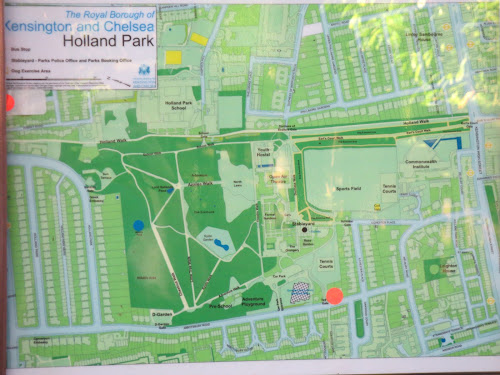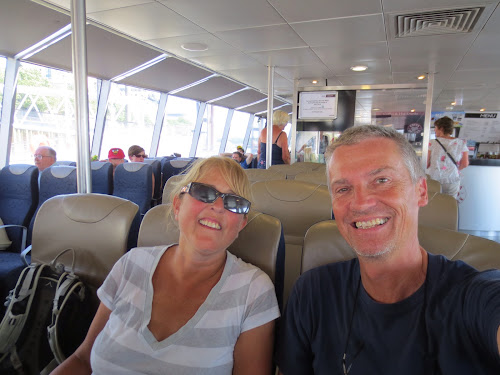Hot day in London, Greenwich Mean Time and a BIG BIG day for us with lots of photos...
Hans started his day early with a morning wander through our local park - Holland Park.
London parks are generally of a high standard with a mix of nice gardens, paths and sporting areas.
Holland Park even has a tea house (closed at this time of day). This is where we went for tea with Di's mum's friend Carolyn last time we were here in 2010.
Holland Park is also doing Opera in the Park with open air movies to follow later.
It was peaceful as Hans has much of the park to himself. He was amazed with all this exercise equipment that a local guy was using. The widest selection of outdoor exercise machines that we had even seen. May be back one morning to try it out...
Back to our hotel which is quite a nice older building. Our room is on the top floor at the back.
You could see the window to our room on the grey building on the top right to the left of the down pipe.
After our usual breakfast downstairs we decided on a day in Greenwich.
Di had done some research and found that the most convenient way for us to get there was something called DLR (Docklands Light Railway) from Tower Hill. DLR have driverless trains, like those at the airports, but attended by one Passenger Service Agent who made station announcements and checked closing doors. This system appeared to have been introduced for the London Olympics in 2012 and to support the increasing development on the east docklands. We moved around - last row for Di ...
Then front row seats for us.
The stations are all very new and do seem to be used by more than just tourists. You can see a feature of London in the background of this photo - the "Gherkin" building in the heart of the financial district.
We arrived at Cutty Sark station and something here seems to have gone wrong with the planning. The station is too short both at the front and back by about 1 carriage either way. You had to move fast when you realized that...
We liked Greenwich straight away - the local streets down by the Thames are full of character buildings (not many new) and surrounding the area are a lot of Old Royal Naval College buildings now hosting a range of museums and galleries.
We wandered through the Maritime Musuem grounds and found a shady spot for a fruit and drink break. Hans relaxed with the grand old college buildings in the background.
Our view the other way was through the Greenwich Park and up the hill to the Royal Observatory - where THE Greenwich Mean Time line is. Our next destination. A small side note, a few TripAdvisor reviewers had made a note to go here first so you had enough energy to get up the "big hill". Where??? That one???
Flamsteed measured the earths movement by plotting stars crossing his Meridian line. Therefore GMT.
Like all punters who come to Greenwich, we queued to take photos with THE line. Di waiting patiently here. It took about half an hour.
Yep, a typical tourist photo - Di is east and Hans is west. The line is 0 degrees longitude - where east meets west.
Di split east and west...
Hans made an impact with the crowd with this pose, known as his "Four Corners" pose (see our Four Corners visit in the US...)
In 1714 during the reign of Queen Anne, they offered a large monetary reward (Longitude Prize) for anyone who could find a simple and practical method for the precise determination of a ship's longitude. A guy called John Harrison one (gradually - awarded in a few blocks over a period of about 40 years) the £20,000 prize. His winning longitude marine chronometer, H4, is in the distant case. It looks like a normal, but large fob watch, and was used as the basis for all marine chronometers from that point on. The previous version is in the case in the foreground. Talk about a developmental leap!
Looking back at some of the Old Naval college buildings. The colonnade you see is where we took our earlier break.
The Olympic arena stands out.
The building behind Di is our other major destination for today. The Painted Hall at the Old Royal Naval College. Guess what it was intended to be? Maybe you woukd guess a church? Or court? Or something posh for the royals?
Nope. All wrong. The painted hall was intended and we quote "as an eating space for the naval veterans...who lived here at the Royal Hospital for Seamen". Yes, it was supposed to be a hospital dining room.
And this is what came out...
Even the vestibule ceiling.
So guess what happened? On completion it was found to be far too grand for everyday use (no kidding) and became London's first tourist attraction! They charged money for people to come and see it. Today it is free...
We did like that the original benefactors had their names painstakingly painted high on the vestibule walls.
In a few places there are mirrors that help you look at the ceiling without breaking your neck. Above Hans you can see the naval theme - a British Man-O-War.
And of course the Painted Hall was so grand that they used it for serious events - like this...Nelson lay in state here while 30,000 members of the public came to pay their last respects.
The Painted Hall was all a bit hard to take in. We bet you see new things on the walls etc every time you look at it. Amazing.
In comparison, the hospital chapel in the building opposite is plain. We did like this statue though - reminded us of "Life of Brian".
Standing down by the Thames we looked back through the Old Royal Naval College grounds towards the Royal Observatory and we noticed a plaque on the ground.
Wow - the history here keeps on impressing us.
The Thames. Not pretty and Hans insisted that behind Di was a beach. No way will she be sunbathing there! The Thames is very tidal and rises and falls about 20 feet every day.
The Cutty Sark was one of the fastest and last built British tea clippers. It had a museum and display but we just wandered around the outside.
Around 2pm we looked for lunch and liked this place - a queue out the door of a group of Chinese trying to get in. It was packed, even with communal tables and benches.
We squeezed in and chose from the huge cheap menu and watched the well orchestrated mayhem that was the delivery of food via these food lifts from the basement kitchen. About 8 waiters whizzed around. Hans managed this one "quiet" photo out of about 4 attempts. Lots of fun to watch.
The food was fine, nothing special, but plenty of it.
We decided to take a different scenic route back towards town and bought a fast ferry ticket along the Thames to Embankment. It was a popular choice.
Very spacious and comfortable inside.
We had some interesting sights along the way (about 40 minute trip). This is a old developed wharf area east of Tower Bridge. Looked nice and we are sure the apartment we saw along the way were worth a few quid or two (or maybe several million).
A nice place to live with history everywhere.
A different view of Tower Bridge. We passed under a lot of bridges (apparently there are more than 20 bridges across the Thames in the London area).
Of course this is the most famous.
Apparently this new building is the tallest in Western Europe. Hans took an instant dislike to it - reminded him too much of how the World Trade Centre looked like after it crashed down...
Getting off the ferry was the least efficient part. The service itself to that point had been great, but now we were faced with 1 guy checking each ticket one by one. There was soon a long queue.
From Embankment we took the tube to Earls Court and found a road heading northwards towards where we lived. An easy 15 minute walk meant we were home by 4.30pm to rest and clean up.
After a break in the room and getting refreshed, we were on our way to Churchill Arms, a pub on Kensington Church Street which was only a 15 minutes busride away from London Visitors Hotel.
We were catching up with Mark Dwyer at 7pm. Hans used to work with Mark, an Irishman, in Sydney back in the late 80s. We did catch up with Mark when we were here in 2010 and again when he was visiting Sydney some time later that year.
We arrived some 10 minutes early, made ourselves at home with a pint each (Czech for Hans and cider for Di) and checked out the Churchill Arms. Of course, the place had lots of Winston memorabilia but also a lot of stuff, for a better word, hanging down from the ceiling.
Mark arrived and Slainte to that...
Gold records awarded to Bill Wyman featured on the wall...
Well, back to Mark and the catch up. Mark seemed well and happy and we had burgers and ribs washed down with a bottle of McLaren Vale Shiraz. Lots of reminiscences from time past and updates on our current lives. Mark is dating a Spanish lady from Barcelona living in London with a long name but known as Luz. He has started doing Heat Yoga for 3-4 times a week and claimed good benefits from it and we believe it showed. He looked really well.
Mark looked pleased with the proceedings...
We packed up just before 11pm, and where the heck did that time go from 7pm. Mark had to be back to work on Friday from 8am and didn't have the luxury of our time flexibility. We grabbed a double decker bus on Kensington High Street and only a few stop later we were home and... the room was baking hot. Mark had said that today was the hottest day of 2013 in London, and we believed him.
A full on and very pleasant day. Good night, although ours was not the best for sleeping as English residences are clearly not built for "heat waves". We managed.






























































No comments:
Post a Comment